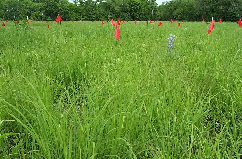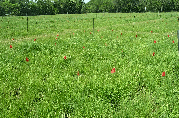Restoration Research at KPBS
 The goal of restoration ecology is to repair the diversity and dynamics of ecosystems degraded by human activities, but also presents a valuable opportunity for basic research aimed at testing ecological theory. Restoration studies in tallgrass prairie are particularly timely because human activities have resulted in widespread loss and degradation of this ecosystem. The nearly irreversible nature of plant composition once established from seed mixtures underscores the critical need to understand factors influencing diversity and functional response (above and belowground) of restored systems at the onset, over the long term, and in response to global change.
The goal of restoration ecology is to repair the diversity and dynamics of ecosystems degraded by human activities, but also presents a valuable opportunity for basic research aimed at testing ecological theory. Restoration studies in tallgrass prairie are particularly timely because human activities have resulted in widespread loss and degradation of this ecosystem. The nearly irreversible nature of plant composition once established from seed mixtures underscores the critical need to understand factors influencing diversity and functional response (above and belowground) of restored systems at the onset, over the long term, and in response to global change.
Restoration research at KPBS aims to test and develop basic hypotheses in ecology, while striving to address applied questions related to improving the structure, function, and sustainability of restored tallgrass prairie systems. Restoration research spans plant, soil, and ecosystem response to disturbance and subsequent recovery through ecological restoration, with an emphasis on the conversion of cropland to native grassland. Our approach to understanding potential feedbacks between plant community development and recovery of soil structure and function in restored systems has been largely experimental with the goal of using this information to guide restoration and advance ecological theory.
In 1998, the first restoration experiment was established to evaluate the role of soil resource availability and heterogeneity in the restoration of plant community structure and ecosystem processes (Baer et al. Ecology 2003, Baer et al. Oecologia 2004, Baer et al. Restoration Ecology 2005, Baer and Blair Ecology 2008). This experimental restoration manipulates two factors known to influence plant diversity in native prairie (i.e., soil depth and nitrogen availability). Results from this work have demonstrated that nutrient availability is a strong determinant of diversity by increasing dominance of grasses at the expense of other species that contribute most diversity. In the early years of this experiment, reducing available nitrogen in the soil reduced the presence of non-native species and promoted diversity. Longer-term studies have documented significant increases in soil carbon and nitrogen over time, but no differences in root biomass or productivity in contrasting soil fertility treatments due to increasing abundance of legumes in nitrogen-reduced soil.
A second restoration experiment was established in an agricultural field at KPBS in 2005. This experiment examines consequences of human decisions in restoration, specifically the selection of dominant grass source populations (i.e., cultivar vs. locally collected seed sources), used in prairie restoration on leaf-level processes, mutualistic associations, root dynamics, competitive interactions, community structure, and ecosystem processes. The premise of this experiment is that if cultivars are selected and bred for traits such as high biomass production, reproductive output, and drought resistance, then these sources may be competitively superior to the non-cultivar (local ecotype) sources. This is particularly relevant to the success of tallgrass prairie restorations, as diverse communities can be difficult to achieve when grasses dominate these restored systems. The experimental design consists of plots sown with either cultivars or locally collected sources of the dominant grasses. A parallel experiment was also set up in Belleville, Illinois to generalize responses across a precipitation gradient. A third and related set of cultivar and non-cultivar plots was established in Carbondale, IL to intensively monitor physiological, population, community, and ecosystem changes during restoration with these different source populations. Thus far cultivars exhibit different root architecture (i.e., greater root length, surface area, and volume) than non-cultivars of the grasses (Klopf and Baer Restoration Ecology 2009), and cultivars show equivalent or enhance physiological performance that non-cultivars (Lambert et al. Restoration Ecology submitted). Whether these traits scale to affect community structure and ecosystem function will be investigated over the long term.
 Restoring tallgrass prairie plant communities in agricultural fields at KPBS will be ongoing. We aim to establish a “chronosequence” of restorations using similar species and techniques over the long term to examine whether inter-annual variation in environmental conditions is a strong organizing force on community assembly. Furthermore, the chronological sequence of restorations with controlled factors of soil type, land-use history, seeding rates, species pools and management can be used to more accurately quantify belowground recovery from disturbance relative to other chronosequence studies. Understanding the role of inter-annual abiotic and biotic variation on the restoration of plant community structure and ecosystem function will help us forecast these restored systems response to environmental change and broadens the relevance of research at KPBS to regions where restorations constitute more grassland area than native prairie that has never been cultivated.
Restoring tallgrass prairie plant communities in agricultural fields at KPBS will be ongoing. We aim to establish a “chronosequence” of restorations using similar species and techniques over the long term to examine whether inter-annual variation in environmental conditions is a strong organizing force on community assembly. Furthermore, the chronological sequence of restorations with controlled factors of soil type, land-use history, seeding rates, species pools and management can be used to more accurately quantify belowground recovery from disturbance relative to other chronosequence studies. Understanding the role of inter-annual abiotic and biotic variation on the restoration of plant community structure and ecosystem function will help us forecast these restored systems response to environmental change and broadens the relevance of research at KPBS to regions where restorations constitute more grassland area than native prairie that has never been cultivated.
Restoration research at KPBS has been referenced in two books [Foundations of Restoration Ecology by Falk et al. (eds.) 2007; Grasslands and Grassland Ecology, D. J. Gibson, 2009] and multiple high profile scientific journals including Nature (Harpole & Tilman 2007), Proceedings of the National Academy of Sciences of the United States (Suding et al. 2005), Frontiers in Ecology and the Environment (Johnston et al. 2004), and BioScience (Turner et al 2003). Restoration research at KPBS was profiled the feature article “Prairie revival: Researchers put restoration to the test” in Science News [December 15, 2007] and an article entitled “Restoration drama: the science of ecology is helping to bring ecosystem services back to Market” published in The Economist [August 8, 2002].